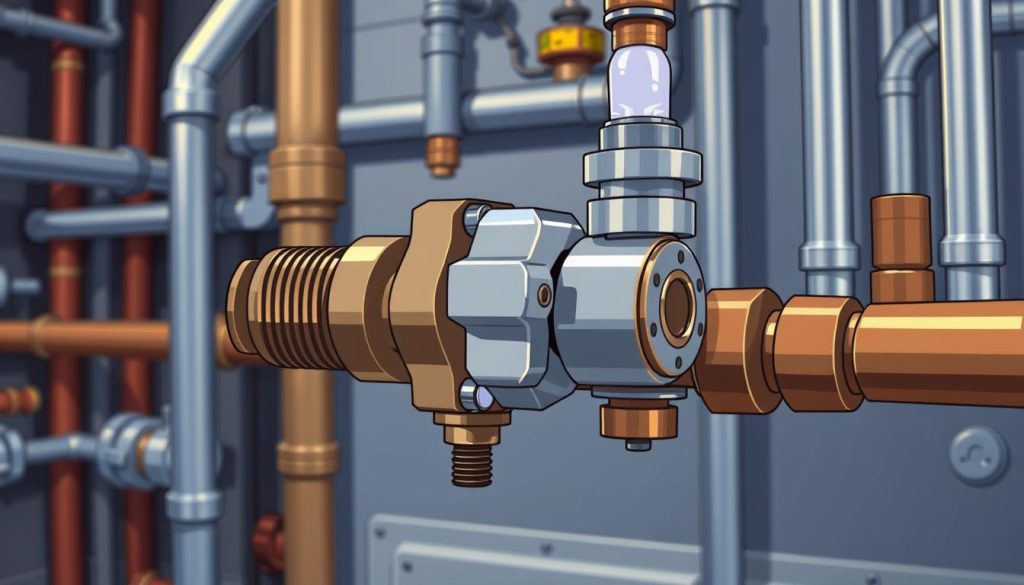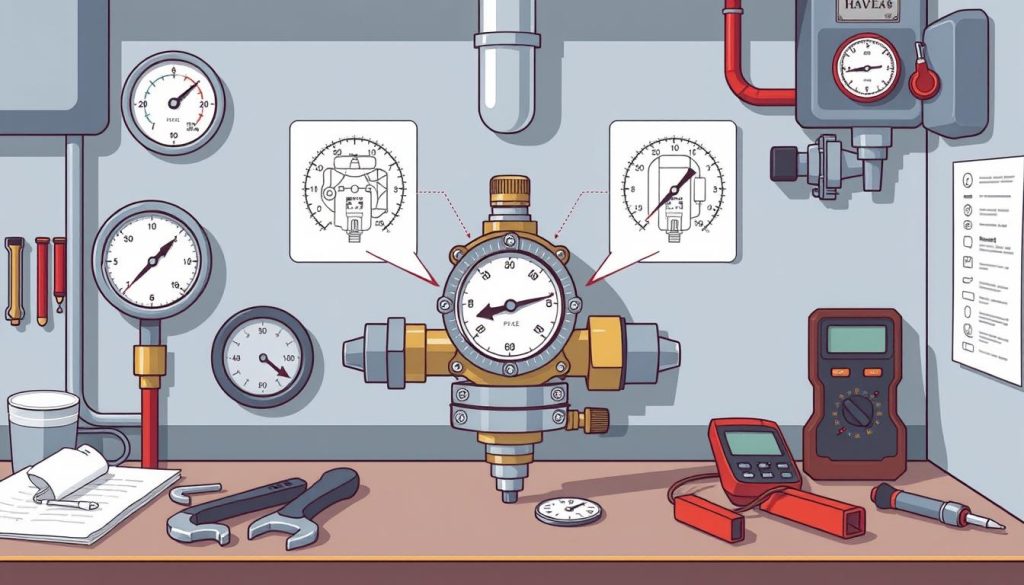In the HVAC world, “TEV” means “Thermostatic Expansion Valve.” It’s key for keeping industrial and commercial cooling or heating systems running smoothly. This valve helps control the flow of refrigerant.
The thermostatic expansion valve is a main part of a refrigeration system. It works with the compressor, evaporator, and condenser. In big places, each cooling unit has its own valve to manage refrigerant flow.
Big names like Emerson, Danfoss, Parker, Sanhua, and Sporlan make these valves. They offer many models to fit different system needs. This lets experts pick the right valve for their project.
Key Takeaways
- The acronym “TEV” stands for “Thermostatic Expansion Valve” in the HVAC industry.
- The TEV is a critical component in industrial and commercial refrigeration systems, regulating the flow of refrigerant into the evaporator.
- Refrigeration systems often have multiple evaporators, each with its own thermostatic expansion valve to maintain optimal performance.
- Leading manufacturers of thermostatic expansion valves include Emerson, Danfoss, Parker, Sanhua, and Sporlan, among others.
- Proper selection and installation of the TEV are crucial for ensuring the efficient and reliable operation of the refrigeration system.
What is a Thermostatic Expansion Valve (TEV)?
A thermostatic expansion valve, or TEV, is key in vapor-compression refrigeration and air conditioning systems. It controls the refrigerant flow into the evaporator. This ensures the system works well and efficiently.
The TEV’s main job is to lower the refrigerant’s pressure from the condenser. It then controls how much refrigerant goes into the evaporator. This is done by adjusting the flow based on the evaporator’s temperature.
How Does a Thermostatic Expansion Valve Work?
The TEV uses a temperature-sensing bulb at the evaporator’s outlet. This bulb is connected to the valve by a capillary tube. It checks the refrigerant’s temperature.
When the temperature goes up, the bulb’s pressure increases. This makes the valve open more, letting more refrigerant into the evaporator. If the temperature drops, the pressure goes down. The valve then closes, limiting the refrigerant flow.
This process keeps the right amount of refrigerant in the evaporator. It prevents too much liquid refrigerant from going to the compressor. It also stops too much superheat at the evaporator outlet. The TEV keeps the system efficient and effective.
Components of a Thermostatic Expansion Valve
The thermostatic expansion valve (TEV) is key in refrigeration and HVAC systems. It controls the refrigerant flow into the evaporator. Knowing the TEV’s parts is crucial for its best performance. Let’s look at the main parts of this important device.
The TEV Body
The TEV body is usually made of brass or stainless steel. It houses the system and has three main connections. These are the refrigerant inlet, outlet, and equalization port. Inside, you’ll find a regulating screw and a plate-shaped head, where the capillary tube connects.
The TEV Bulb and Capillary Tube
The bulb is attached to the TEV body and is at the capillary tube’s end. It contains a fluid that changes with temperature. The capillary tube sends pressure changes to the TEV’s internal parts.
The TEV Diaphragm and Needle Valve
In the TEV’s plate-shaped head, there’s a hermetic diaphragm. It separates the bulb’s fluid from the refrigerant. The diaphragm’s movement controls the needle valve, which opens or closes, regulating refrigerant flow.
The TEV Spring and Adjustable Screw
The TEV also has a spring that works against the diaphragm’s movement. The spring’s force is adjusted with a calibration screw. This allows for precise tuning of the TEV’s operation for the system’s needs.
Understanding the TEV’s components helps in diagnosing and maintaining refrigeration or HVAC systems. This ensures they work efficiently and effectively.
How Does a Thermostatic Expansion Valve Work?
The thermostatic expansion valve (TEV) is key in refrigeration and air conditioning systems. It controls the refrigerant flow into the evaporator. Knowing how it works is important for your system’s efficiency and reliability.
When the system starts and the space is warm, the TEV’s gas-filled bulb is also warm. This makes the gas inside the bulb pressurize, expanding the valve’s diaphragm. With the diaphragm’s force stronger than the spring and refrigerant pressure, the valve opens fully. This lets the most refrigerant flow through the evaporator.
As the room and bulb cool down, the gas pressure in the bulb drops. This reduces the diaphragm’s force. The spring and refrigerant pressure then start to close the TEV. This cuts down the refrigerant flow to the evaporator. This keeps happening until the room temperature stabilizes, and the forces balance out.
The TEV’s skill in controlling refrigerant flow is key for evaporator temperature control and superheat maintenance. It ensures the system works at its best. By adjusting the refrigerant flow, the TEV keeps the temperature right, making the system efficient and preventing problems.
In short, the thermostatic expansion valve is a self-regulating device. It adjusts the refrigerant flow to the evaporator. This ensures efficient refrigerant flow regulation and prevents problems. The TEV is essential for any refrigeration or air conditioning system to work right.
Importance of TEV in Refrigeration Systems
The thermostatic expansion valve (TEV) is key to a refrigeration system’s efficiency. It keeps the temperature right between the refrigerant’s entry and exit from the evaporator. This ensures the system works well and protects important parts from harm.
Maintaining Optimal Temperature Differential
The ideal temperature difference in a refrigeration system is about 5°C (9°F). This difference is crucial for the evaporator’s efficiency. It makes sure the refrigerant leaving the evaporator is gas, not liquid. The TEV is set up to keep this perfect balance, vital for the system’s performance.
Preventing Liquid Refrigerant Damage
If the temperature difference drops below 5°C, some refrigerant might stay liquid. This is bad news for the compressor, which only works with gas. Liquid refrigerant can damage the compressor, making the system less efficient and more energy-hungry.
Maintaining Evaporator Efficiency
On the other hand, if the temperature difference is too high, the refrigerant gets too hot. This can overheat other parts of the system, like the compressor and condenser. It can also lower the system’s overall efficiency.
The TEV controls the refrigerant flow well. This keeps the evaporator running at its best. It boosts the system’s cooling power and saves energy.
In short, the thermostatic expansion valve is vital for refrigeration systems. It keeps the temperature right, protects the compressor, and makes sure the evaporator works efficiently. Choosing the right TEV, installing it correctly, and calibrating it properly are crucial for the system’s performance and life span.
What does TEV stand for HVAC?
In the world of HVAC, TEV is a key term. It stands for Thermostatic Expansion Valve. This valve is vital in refrigeration and air conditioning systems. It controls how much refrigerant flows into the evaporator.
Let’s dive into what makes the TEV important:
- Definition: The thermostatic expansion valve, or TED, manages refrigerant flow into the evaporator. It does this based on system temperature and pressure.
- Function: The TEV keeps the temperature right between the refrigerant’s inlet and outlet. This ensures the system works efficiently and prevents liquid refrigerant from getting to the compressor.
- Components: A TEV has several parts. These include the body, bulb, capillary tube, diaphragm, needle valve, and adjustable spring. Together, they control refrigerant flow.
- Importance: The TEV is a key part of a refrigeration system, along with the compressor, evaporator, and condenser. It’s crucial for the system’s performance and efficiency.
Knowing about the TEV is vital for HVAC professionals. It helps in choosing, installing, and fixing refrigeration and air conditioning systems.
Selecting and Installing a Thermostatic Expansion Valve
Choosing and installing the right thermostatic expansion valve (TEV) is key for your HVAC system’s best performance. You need to think about the evaporator’s size, the refrigerant type, and the system’s operating temperatures.
Selecting the Right TEV
Choosing a TEV involves looking at the manufacturer’s catalog and the refrigerant in your system. You also need to consider the evaporator’s size, the refrigerant amount, and the temperatures. Many makers offer software to find the best valve for your system.
Installing the TEV
The TEV should be placed near the evaporator, using threaded or welded connections. The valve’s bulb must be on the evaporator’s outlet tube, covered to keep it warm. If welding is used, a wet cloth protects the valve’s inside.
Also, a refrigerant tap should be added at the evaporator’s outlet. This tap helps measure the refrigerant pressure at the equalization port.
| Consideration | Explanation |
|---|---|
| Evaporator Capacity | The TEV must be sized to match the evaporator capacity, ensuring proper refrigerant flow and system performance. |
| Refrigerant Type | The TEV must be compatible with the specific refrigerant used in your HVAC system. |
| Operating Temperatures | The TEV must be able to handle the expected range of operating temperatures in your HVAC system. |

By picking and installing the correct thermostatic expansion valve, your HVAC system will work at its best. This means better comfort and energy savings for you.
Types of Thermostatic Expansion Valves
There are two main types of thermostatic expansion valves (TEVs) in HVAC systems: internally equalized and externally equalized. Knowing the difference between them is key for the best performance and efficiency in your cooling or heating setup.
Internally Equalized TEVs
Internally equalized TEVs check the pressure at the evaporator coil’s inlet. They connect internally to the valve’s outlet. This setup works well for most systems but might not handle high-pressure drops or multiple evaporators.
Externally Equalized TEVs
Externally equalized TEVs measure the pressure at the evaporator coil’s outlet. They can handle pressure drops, making them versatile for various HVAC needs. This includes systems with high-pressure drops or multiple evaporators.
Choosing between these TEV types depends on your HVAC system’s design. This includes evaporator design, pressure drop compensation, and the types of thermostatic expansion valves needed for top performance.
Understanding the differences between these TEV types helps you make the right choice. This ensures your HVAC system runs efficiently, providing reliable comfort and performance for your space.
Troubleshooting and Maintenance
As a homeowner or HVAC technician, knowing how to fix and maintain your Thermostatic expansion valve is key. This ensures your refrigeration system works well. Let’s look at some common problems and how to solve them with TEV maintenance and refrigeration system issues.
Identifying Superheat Problems
Superheat is a big deal with a thermostatic expansion valve. It’s the difference in temperature between the refrigerant leaving the evaporator and its saturation temperature. If it’s too low, you might find liquid refrigerant detection in the compressor, which can damage it. Too high, and your system won’t be as efficient.
Addressing Refrigerant Charge Issues
A low refrigerant charge can make your thermostatic expansion valve and evaporator sound loud. This happens because there’s no liquid before the valve’s orifice. It tries to meter vapor or a mix instead of liquid. Getting the refrigerant charge right is key for TEV maintenance and good system performance.
Preventing Superheat Hunting
Cross charges can help by making the valve orifice not close too much. Or, bleed passages keep a small refrigerant flow going. This helps keep the thermostatic expansion valve stable.
By tackling these common TEV maintenance and refrigeration system issues, you can keep your system running smoothly. This avoids expensive Thermostatic expansion valve troubleshooting later on.

Conclusion
The thermostatic expansion valve (TEV) is key in vapor-compression refrigeration and air conditioning systems. It controls the refrigerant flow into the evaporator. This ensures the system works efficiently and prevents damage.
Choosing the right TEV is important. It depends on the evaporator’s size, the refrigerant type, and the system’s temperature. There are two main types of TEVs, each handling pressure differently. Keeping the TEV in good shape is vital for your system’s health.
In short, the TEV is essential for your HVAC system’s performance. It manages refrigerant flow and keeps the evaporator at the right temperature. Knowing how it works and keeping it maintained can make your system run better and last longer.





0 Comments